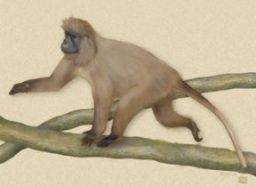New mammals
Wildlife biologists have discovered a new type of monkey and an unusual rodent.
By Emily Sohn
We often hear about animals that are disappearing. As people destroy forests, spoil rivers, and ruin other vital habitats, animals and plants are becoming extinct at a rapid and alarming rate.
Now, brace yourself for some good news.
Two groups of researchers in Africa have identified a new species of monkey previously unknown to science. Meanwhile, another group of researchers has discovered a strange, new type of rodent in Laos that belongs in its own family. It’s the first time in 31 years that anyone has found an entirely new family of any type of mammal.
 |
|
A newly described species of mangabey, baboon-size with an unusual crest of hair and a loud, honking bark, lives in Tanzania.
|
| Z. Deretsky/National Science Foundation |
The new monkey is called the highland mangabey, or Lophocebus kipunji. Tim Davenport of Mbeya, Tanzania, and his team found it after checking out stories of a shy monkey with an unusual appearance around Mount Rungwe in Tanzania.
When the biologists saw the animal, they were able to get a good enough look to identify it as a new species. Davenport works in Tanzania for the Wildlife Conservation Society.
At about the same time, wildlife biologist Trevor Jones followed reports of what people thought were endangered monkeys called sanje mangabeys. The monkeys were spotted living in a certain remote forest of Tanzania, about 370 kilometers away from Mount Rungwe.
When Jones started exploring the site, he saw brown monkeys with high crests of hair. These, he knew, were not sanje mangabeys. “I was immediately gobsmacked,” he says. The monkeys turned out to be highland mangabeys.
It’s extremely rare to find an entirely new monkey species, especially in Africa. Most recent finds have been in Asia. Researchers are now calling for an immediate end to logging in the areas where the new monkeys live. The fear is that the monkeys may disappear as suddenly as they were discovered. Their habitats are already dwindling.
In Asia, the new rodent was discovered by a team working in forested areas of Laos. The team, which is sponsored by the Wildlife Conservation Society, has surveyed the environment and local markets for years.
 |
|
Scientists found the kha-nyou, a new rodent species about the size of a squirrel, during a survey of Laotian village markets.
|
| Robert J. Timmins |
Since 1996, the researchers have occasionally bought an animal that local people call kha-nyou. It looks a bit like a rat with extra-long whiskers, dark fur, and a furry tail. Its average size is about 25 centimeters (nearly 10 inches) long.
Recently, the WCS team asked scientists who classify animals to look at the rodent’s teeth, bones, and DNA. These scientists decided that it belongs in a new mammal family called Laonastidae. The rodent’s scientific name is now Laonastes aenigmamus.
Both discoveries are exciting hints of a world full of secrets still remaining to be discovered.—E. Sohn
Going Deeper:
Milius, S. 2005. New mammals: Coincidence, shopping yield two species. Science News 167(May 21):324. Available at http://www.sciencenews.org/articles/20050521/fob3.asp .
The Wildlife Conservation Society has a Web site at www.wcs.org/. You can learn more about the highland mangabey at www.wcs.org/353624/mangabeypressrelease. Information about the new rodent is available at www.wcs.org/353624/13145867.







